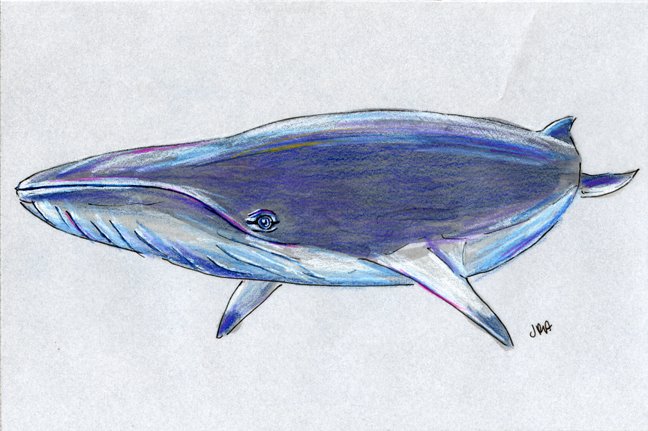The common minke whale is the smallest of the rorquals, and one of the smallest baleen whales (second smallest only to the Pygmy Right Whale). Except for the dwarf form, length ranges from 7 to 9.8 meters and weight ranges from 5 to 10 tons.[5] On average, females are about 0.5 meters longer than males.[5] Newborns range from 2.4 to 3.5 meters.[5] The dwarf form has a smaller adult length of up to 7.8 meters.[5]
The back is dark grey and the belly white. All forms have a pale chevron above the flippers or behind the head. All forms also have a white or light marking on each flipper. On the dwarf form the white marking covers most of the flipper. On the northern forms, there is a distinct white band running horizontally through the middle of each flipper. This band is more grey in the Scammon’s minke whales.[5]
The common minke whale differs from the Antarctic variety in several aspects. The common species is slightly smaller than the Antarctic, which has much less white marking on the flippers. There are also less distinctive differences in body coloration and shape.[5]
Common minke whales have a disjointed distribution. The non-dwarf forms live in the north Atlantic and north Pacific Oceans. The Scammon form is also from the north Pacific. The dwarf form has a distribution completely separate from the other forms, living in southern oceans, and has a distribution generally north of the Antarctic species, although there is some overlap.[5]
(From Wikipedia.org, September 29 2010)
– – –
Minke whales feed on fish and various invertebrates; like all baleen whales they filter their food from the water using their baleen plates like sieves (2). Although largely a solitary species, when feeding minke whales can often be seen in pairs, and on particularly good feeding grounds up to a hundred individuals may congregate (2). A number of feeding techniques have been observed, including trapping shoals of fish against the surface of the water (7). After a ten month gestation period, births occur in mid-winter (2), at birth the calf measures up to 2.8 metres in length (5). It will be weaned at four months of age (3), and will stay with its mother for up to two years, becoming sexually mature at seven years of age (7). Minke whales have an average life span of around 50 years (7). Minke whales are fairly inquisitive and often swim by the side of boats for up to half an hour (5).
(From ARKive via The Encyclopedia of Life, September 29 2010)




